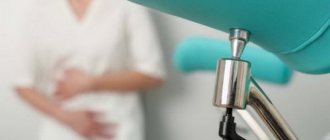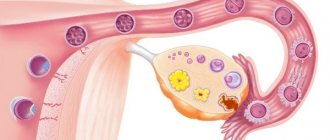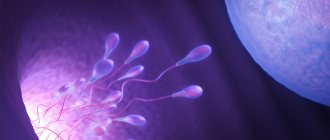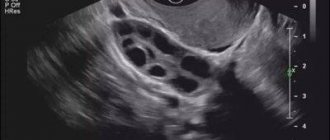- About conception
- Diseases
The relevance of problems associated with conceiving a child is difficult to overestimate. The inability to get pregnant is a consequence of various diseases and disorders. One of them is luteinization of the follicle.
This syndrome is a common phenomenon in gynecology, which refers to the endocrine form of infertility. It is detected in 12-47% of women of reproductive age. The frequency depends on the degree of damage to the endocrine system, age, and the condition of the internal organs.
The process of movement of an egg (second-order oocyte) from the ovary into the body cavity.
How does this happen?
A follicle is a cavity formation inside the ovary. A woman is given a supply of follicles for life at birth, but they become active only with the onset of puberty. From this moment, folliculogenesis begins, the processes of which are repeated every month.
After menstruation, several enlarged antral follicles appear in the ovaries. They are small in size - 2–4 mm, there can be up to 25 of them. But only one matures (very rarely - two, with double ovulation). The remaining bubbles regress to their original state; their time has not yet come.
The dominant follicle, under the influence of follicle-stimulating hormone, reaches a size of 20–24 mm, and from this moment it is ready for ovulation. For a break to take place, the female body increases the production of estrogen, which, in turn, provokes an increase in the hormone LH. This hormone makes the follicular membrane thinner, it bursts and releases a mature egg. From this moment, within a day or a day and a half, a woman can conceive a baby if her egg meets a sperm and fusion takes place.
Ovulation usually occurs in the middle of the cycle, separating its two phases - follicular and luteal. With a 28-day cycle, ovulation usually occurs on the 14th day of the cycle, and with a 32-day cycle - on the 18th day.
To determine the estimated day of your ovulation, you need to subtract 14 from the normal duration of your cycle. This is how many days the second half of a woman’s cycle usually lasts, regardless of age or the length of the cycle itself.
The complex mechanisms associated with the reproductive system are controlled by hormones. Preparing a woman for pregnancy largely depends on the follicles, therefore, a large number of women are interested in the question of when this should happen.
How to treat?
The syndrome requires complex treatment. It's very complex. The therapeutic course is selected taking into account the causes of the disease and depends on what cause caused the disorder. If stress led to luteinization of the follicle, the patient is generally healthy, and reproductive function is easily corrected. When the syndrome is accompanied by inflammatory diseases of the ovaries, treatment is aimed at eliminating them. If necessary, the doctor prescribes hormonal medications to normalize ovulation and prolactin levels.
Physiotherapeutic methods include microwave treatment and electrophoresis. In addition to medication and physiotherapy, there are ways to physically stimulate ovulation. The most effective of them is acupuncture. It helps normalize the activity of the central nervous system and increase the level of biologically active substances, including ovarian hormones.
Often a woman is prescribed a course of vitamins. They will help improve health, increase resistance to stress and improve the functioning of the body's reproductive system. If conservative treatment fails, the doctor decides on surgical intervention. During this procedure, tissue from the damaged part of the ovary is removed.
Patients with endocrine forms of infertility are at risk for unfavorable pregnancy and complicated childbirth. If pregnancy occurs after treatment, regular monitoring by a gynecologist is recommended.
Prevention consists of timely detection and treatment of gynecological diseases and endocrine disorders. Diagnosis and treatment at an early stage guarantees a positive result and pregnancy. If luteinization syndrome is suspected, a woman should undergo a thorough examination and also follow all doctor’s instructions
.
Similar articles
Diagnosis of multifollicular ovaries. Do they need to be treated?
Symptoms, causes and methods for eliminating adhesions on the ovaries
Types and signs of female infertility
Tumor and enlargement of the ovary in women
What is a follicle?
A follicle is a small anatomical formation in the form of a sac, which has an intracavitary secretion. They are located in the cortex of the ovary, this is the main reservoir for the egg that matures.
Primary follicles contained in the cortex of the two ovaries of an intrauterine fetus can reach millions! Each one contains at least one reproductive cell. But only 20-30 per cycle are ready for fertilization.
Granulosa and granular cells actively develop in the follicular sac. Then the granular cells produce a fluid that pushes and pushes the cells apart, after which they are directed to the peripheral parts.
The internal cavity is filled with follicular fluid, and the follicle itself grows rapidly . If at the very beginning it was a compact formation, now it is a large bubble, the diameter of which can reach 20 mm . Inside it there is a protein liquid, there are also salts and other substances. On the outside, everything is covered with a connective sheath of fabric. It develops fully during a woman's puberty, usually by age 15.
Which one is called dominant?
It is a mature follicle , in which the egg is fully prepared for ovulation, and this is exactly what it demonstrates. But she does not immediately leave the protective shell; she first needs to go through the stages of her development.
This process is called folliculogenesis , it is under the control of the two most important systems in the human body - the endocrine and nervous. The main goal of this process is to ensure that a mature female reproductive cell is fully formed.
How to determine that it has broken down?
- there is pain in the lower abdomen;
- sexual desire increases;
- a large amount of mucus appears in the cervix;
- The color of the discharge often changes.
As for pain, only 20 percent of women experience it . Most often, pain is felt due to mild bleeding, in which the follicle bursts and, in addition to the egg, follicular fluid begins to come out. This is often accompanied by the release of small blood clots.
The pain can be cramping, cutting or stabbing . It can last about an hour, but the time is different for each woman; pain is often felt within one or two days. If you experience severe pain, you should immediately go to the gynecologist.
Painful sensations have a significant impact on a woman's libido . Most often, they experience increased attraction to the opposite sex. Everything is natural here: nature says that right now you should conceive a child.
If you carefully observe the state of the body, you can understand when the follicle burst:
- a few hours before ovulation, discharge begins, which can be observed for several days;
- If we compare the discharge from a burst follicle with the discharge that is observed before and after menstruation, then it is more liquid.
That is, it is liquid discharge that is the main sign that the follicle has burst , which indicates that the woman’s body is ready for pregnancy. The appearance of the discharge during this period resembles egg white, and it “stretches” between the fingers.
You need to pay attention to the color of the discharge , which also changes. Typically, it turns reddish and looks like mild bleeding. The color may be pinkish, but in any case, there should not be a lot of blood.
Conclusion
Many women are interested in the question of why the follicle does not burst in time. There may be several reasons for this:
- the woman is regularly exposed to physical or mental exhaustion;
- exhausting diets and fasting;
- unsuccessful abortion;
- sex life is irregular, the pause between sexual contacts is long;
- gynecological diseases;
- the female genital organs were subjected to surgical intervention.
If the follicle does not burst, you must consult a doctor promptly . If this results in the formation of a cyst, then serious treatment is necessary.
What happens during luteinization of the follicle?
The process of luteinization involves the formation of the corpus luteum. The corpus luteum, in turn, is a temporary gland in the female body. It is formed after ovulation and is responsible for the synthesis of progesterone.
The release of an egg from a mature follicle and the formation of a corpus luteum in it (normal).
At the stage of follicle maturation, a malfunction occurs as a result of which it does not burst and the egg, accordingly, does not come out. Nevertheless, all processes accompanying ovulation continue to run their course. A corpus luteum forms inside the unruptured follicle, and the hormone progesterone is released into the blood. At this moment, you can observe all the signs of ovulation, but in fact it did not happen.
Important! Unovulated follicle luteinization syndrome refers to the premature formation of the corpus luteum (luteinization), which occurs without ovulation. This disorder is accompanied by a change in the production of progesterone, as well as untimely transformation of the secretion by the endometrium.
What is a follicle
The maturation of the follicle is a rather complex process and begins in the first half of the menstrual cycle under the influence of special hormones. In one monthly cycle, more than two dozen follicles mature, but only one dominates. The egg is subsequently released from it. This is how ovulation occurs.
With a constant monthly cycle, on the seventh day you can see mature follicles using ultrasound - they look like vesicles or sacs. If the study is repeated after a few days, you will see that one bubble is slightly larger than the others. Therefore, the egg will be released from it. Having increased in size to 20 mm, the sac ruptures and ovulation occurs. In its place a corpus luteum appears, which resolves on its own after some time. The corpus luteum produces hormones necessary for pregnancy.
A little about ovulation
During the early follicular phase, several follicles are formed at once. They continue to increase in size, but at one point one of them outstrips the rest of the immature ones in growth. Such a follicle is called dominant. During the period when it is released from all follicles, its parameters are about 15 mm. Others begin to develop back (atresia). By the time the dominant follicle should burst, the size reaches 18-24 mm.
Before normal ovulation, an ultrasound scan determines the presence of a mature follicle. Then he disappears. At the site of the burst follicle, a corpus luteum forms.
Relationship between follicle and ovaries
The ovaries are one of the main organs on which the reproductive state of a woman’s body depends. Scientists have found that at the moment when the woman herself was in the intrauterine state, she formed about a million eggs. The older a woman gets, the fewer eggs she contains. Closer to fifty years, the eggs disappear, and menopause occurs. These organs are paired and are connected through the appendages to the uterus. One ovary is slightly higher than the other, and the right organ is slightly heavier than the left. If one of the ovaries is chronically ill, or if it is removed, a woman still has a chance to become a mother; the main condition is the functionality of the remaining organ.
It is in the ovary that the egg is located, which, when mature, breaks out of the follicle and moves towards the sperm. If conception does not occur, the ovaries perform their function again, and this is repeated every menstrual cycle, until the onset of menopause.
The ovaries perform three main functions:
- Vegetative. (Appearance of primary and secondary sexual characteristics);
- Generative. (Egg formation);
- Hormonal. (Production of the following types of hormones: androgens, estrogens and progesterones).
During ovulation, the ovaries increase in size, this is clearly visible on ultrasound images. A woman can, based on her own feelings, find out exactly when she will ovulate:
- Within a few days, mucous discharge of a transparent color appears;
- Slight pain may appear in the lower abdomen;
- On the day when the ovarian follicle ruptures, the basal temperature drops and then rises again;
- When taking a test for the LH hormone, the doctor will notice its elevated level.
Sometimes two follicles mature at the same time. In this case, the woman will have a twin pregnancy if fertilization is successful.
One of the common causes of infertility is immaturity of the follicle. This may happen in the following cases:
- When ovarian dysfunction occurs. In such a situation, the hormonal function of the ovaries is disrupted, and ovulation does not occur. The longer the disease is left untreated, the more the performance of the ovaries decreases.
The main symptoms of dysfunction may be disruptions in the menstrual cycle, lack of ovulation, menstruation is accompanied by severe pain in the lower abdomen, the occurrence of amenorrhea, and miscarriage.
The cause of ovarian dysfunction may be: obesity, inflammatory process in the lower genital organs, chronic diseases of the uterus, appendages, cervix, thyroid disease.










